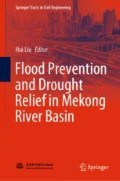Abstract
Mekong River Basin (MRB) has suffered huge injuries and property losses from frequent floods, which would very likely witness an increase of flood magnitude and frequency under climate change. In this chapter, we set up a distributed hydrological model (THREW) to provide fundamental analysis of the flood characteristics in the MRB, the simulation period is 1991–2016, the spatial coverage is the whole basin except the delta region due to lack of reliable topographic data. Two main types of flood in the MRB which are riverine flood and flash flood are discussed. Flood peak frequency at mainstream stations along Mekong are achieved by Pearson-III Frequency Curve Fitting. The annual flood volume and duration at mainstream stations along Mekong River are calculated and analyzed. Taking the flood volume of damaging floods at Stung Treng station (at lower reach of Mekong mainstream) as subject, the THREW model is used to analyze flood’s travel time and regional composition, which would benefit flood prevention and water resources management from a whole-basin view.
Access this chapter
Tax calculation will be finalised at checkout
Purchases are for personal use only
Notes
- 1.
Satellite TRMM, jointly developed and designed by NASA (National Aeronautics and Space Administration) and JAXA (Japan Aerospace Exploration Agency), is mainly used to monitor and study rainfall in tropical regions, actually covering a wide region ranging between 50° N and 50° S on Earth. Satellite TRMM, a low earth orbit satellite at the dip angle about 35°, launched on November 28 1997 in Japan, is the first meteorological satellite specifically used to observe rainfall in tropics and subtropics, carrying sensors such as TMI, PR, VIRS, LIS and CERES. Of devices carried by satellite TRMM, PR is ground breaking designed and made by Japan’s National Space Development Agency (NASDA) and can provide 3D structure of rainstorm, capable of increasing accurate estimation of rainfall. TRMM provides rainfall data ranging between 50° N and 50° S and multiple time intervals in the globe, supplementing rainfall information of no-information regions in the globe.
- 2.
Thiessen Polygons is a method worked out by Holland climatologist Thiessen to calculate mean rainfall on the basis of rainfall of discretely distributed meteorological stations, i.e. connect all adjacent meteorological stations into triangles, draw perpendicular bisectors on each side of these triangles, and connect the crossover points (i.e. center of circumcircle) of three sides of every triangle to obtain a polygon. The rainfall intensity of the only meteorological station within the polygon is used to express the rainfall intensity within the polygon region and such polygon is called Thiessen Polygon.
- 3.
The value range of NDVI is −1 ≤ NDVI ≤ 1, where the negative means the surface is covered with cloud, water and snow etc., high reflectance against visible light; 0 means there are rock or bare soil etc.; positive means it is covered with vegetation, increasing with increasing coverage.
- 4.
MRC (2015) Annual Mekong Flood Report 2014, Mekong River Commission, 70 pages, p 4.
- 5.
Obtained from MRC report Seasonal Flood Situation Report for the Lower Mekong River Basin—Covering period from 1st June to 13rd November 2011.
Author information
Authors and Affiliations
Corresponding author
Editor information
Editors and Affiliations
Rights and permissions
Copyright information
© 2020 China Water & Power Press and Springer Nature Singapore Pte Ltd.
About this chapter
Cite this chapter
Hou, S., Liu, H., Tian, F. (2020). Analysis of Flood Character in the Mekong River Basin. In: Liu, H. (eds) Flood Prevention and Drought Relief in Mekong River Basin . Springer Tracts in Civil Engineering . Springer, Singapore. https://doi.org/10.1007/978-981-15-2006-8_3
Download citation
DOI: https://doi.org/10.1007/978-981-15-2006-8_3
Published:
Publisher Name: Springer, Singapore
Print ISBN: 978-981-15-2005-1
Online ISBN: 978-981-15-2006-8
eBook Packages: EngineeringEngineering (R0)

